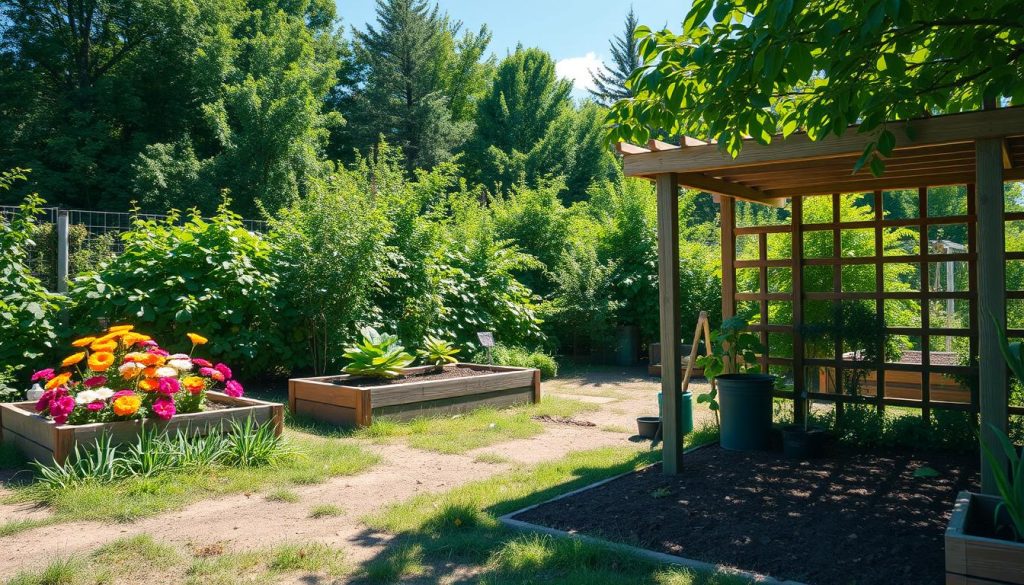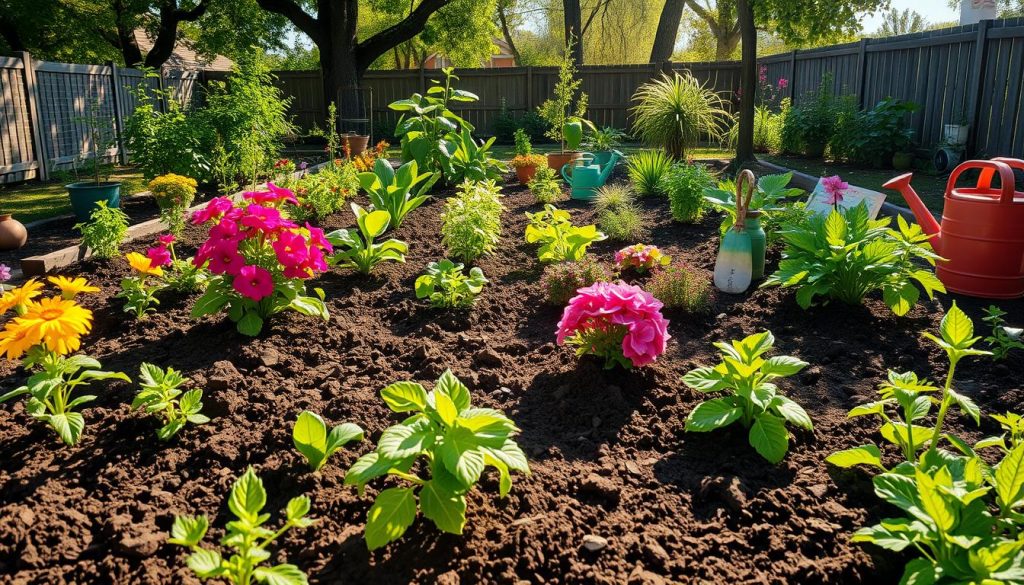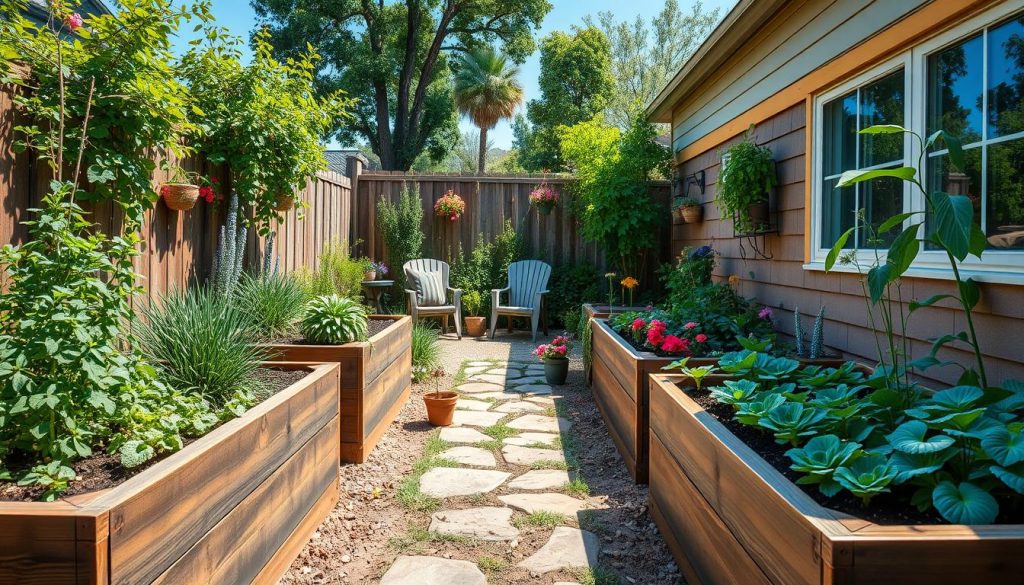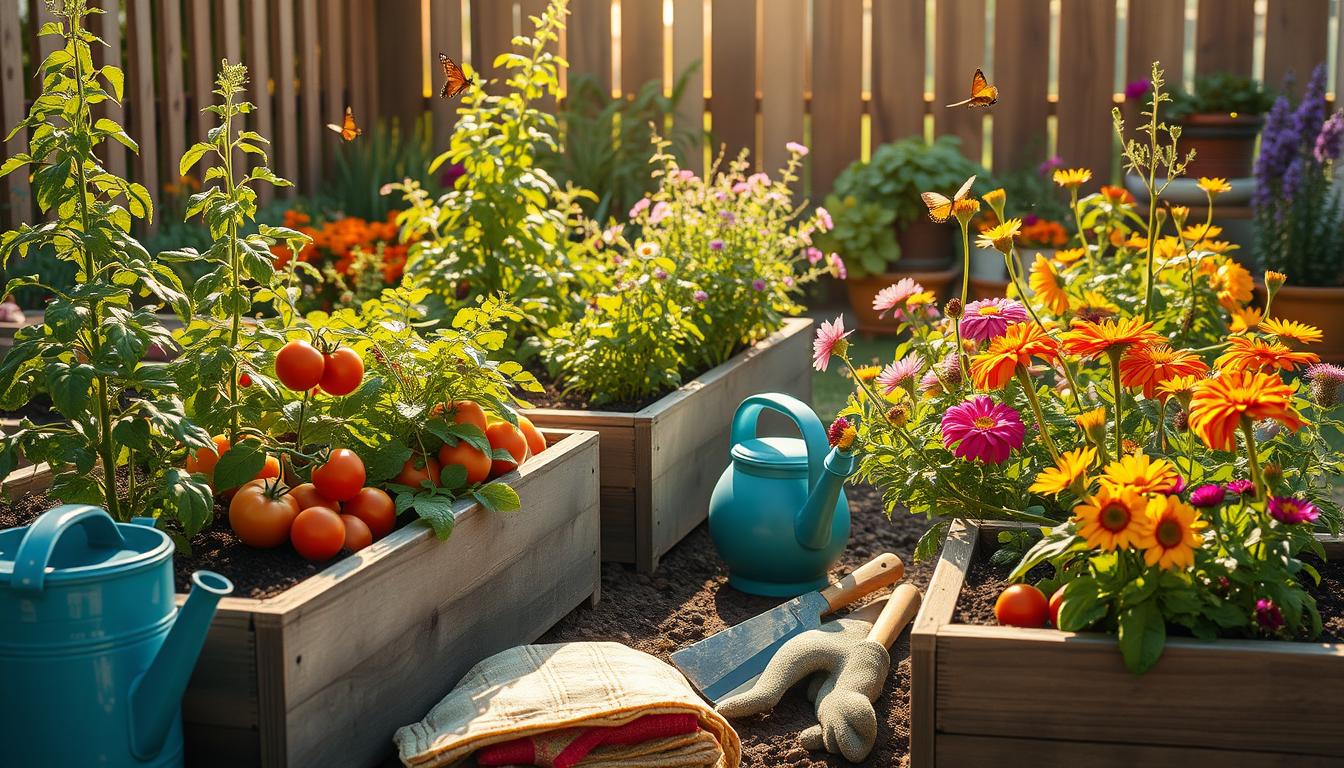I’m excited to share how to start a garden from scratch. This guide is here to help you get started. As a beginner, knowing the basics of gardening is key. That’s what we’ll cover, giving you valuable tips.
Starting a garden might seem daunting, but with the right help, you’ll soon have a beautiful garden. We’ll guide you step by step. Topics include choosing the right spot, picking plants, and preparing the soil. We’ll share tips to help you succeed.
With these tips and a bit of practice, you’ll grow your own fruits, veggies, and flowers. You’ll enjoy the many benefits of having a home garden. You’ll learn how to make your garden thrive.
Understanding My Gardening Goals
Starting a garden from scratch means knowing what I want to achieve. What do I want to grow? Do I have enough space? What’s my budget? Planning a garden is about setting goals and making a plan for success. By defining my objectives, I can create a garden that meets my needs and goes beyond my expectations.
To start, I must think about what I want from my garden. Do I want to grow my own food or create a beautiful flower arrangement? Knowing my goals helps me evaluate my space and conditions. I’ll check the sunlight, soil, and any challenges.
Defining What I Want to Grow
Deciding what to grow is key in planning my garden. I need to pick plants that will do well in my climate and soil. I also think about what I want from my garden, like growing food, creating beauty, or attracting wildlife.

Evaluating My Space and Conditions
Understanding my space and conditions is vital for a successful garden. I’ll check the sunlight, soil, and any challenges. Knowing this helps me choose the right plants and create a thriving garden.
Budgeting for My Garden
Setting a budget is crucial in planning my garden. I’ll consider the cost of seeds, tools, and supplies. I’ll also think about ongoing expenses like watering and maintenance. A budget helps me keep my garden sustainable and fun without overspending.
Choosing the Right Location
Choosing the right location is key to a successful garden. It’s a crucial step in any gardening guide. The right spot can greatly improve your plants’ health and productivity.
Start by thinking about your plants’ sunlight needs. Most plants need at least 6 hours of direct sunlight a day. Here are some things to think about when picking a spot:
- How much direct sunlight the area gets
- If trees or structures might block sunlight
- How easy it is to water and maintain the garden
Also, think about your garden’s design and use. A well-designed garden is both useful and beautiful. It makes spending time there enjoyable. By following a gardening guide and considering these points, you can create a thriving garden.
Here’s a simple table to help you check your garden’s location:
| Location Factor | Considerations |
|---|---|
| Sunlight | 6 hours of direct sunlight per day |
| Accessibility | Easy access for watering and maintenance |
| Design | Functional and beautiful design |

Selecting Plants for My Garden
Choosing the right plants for your backyard garden can be tough. There are so many options, and it’s key to pick what will do well in your climate and soil. Easy gardening techniques can help you create a beautiful garden that’s also productive.
Start by thinking about the types of plants you want. You can pick seasonal plants for color and variety, or go for perennials for something that comes back every year. Seasonal plants add a pop of color, while perennials are easy to care for.
Seasonal Plants vs. Perennials
- Seasonal plants: These plants complete their life cycle within a year and need to be replanted every season.
- Perennials: These plants come back year after year and require less maintenance than seasonal plants.
Local Adaptations and Popular Choices
Think about plants native to your area and what will do well in your climate. Look at what other gardeners in your area like too. Choosing plants that fit your area well means a garden that thrives with little effort.

Companion Planting Basics
Companion planting means growing different plants together to help each other grow. It’s a way to make your garden better without using many chemicals. For example, marigolds help tomatoes, and basil is great with lettuce.
Preparing the Soil
Starting my garden, I see that soil prep is key. Simple garden designs can greatly enhance my garden’s look and feel. First, I test my soil’s pH and nutrient levels. This tells me what to add for the best growing conditions.
Soil quality is crucial when starting a garden. I can test it by sending a sample to a lab or using a DIY kit. After getting the results, I add compost or manure to improve it. This helps my plants grow well and give a good harvest.
Testing Soil Quality
- Send a soil sample to a lab for analysis
- Use a DIY testing kit to determine pH level and nutrient content
- Check for contaminants like heavy metals or pesticides
Amending the Soil for Optimal Growth
With my soil test results, I start making it better for growth. I add compost or manure to improve its structure and fertility. I also use fertilizers to fix any nutrient gaps. Preparing my soil well means a healthy, productive garden with fresh produce for months.

Best Practices for Tilling
After preparing my soil, I till it to make it smooth for planting. I loosen the soil to 8-10 inches deep and rake it. These steps help me create a beautiful, productive garden that will bring joy and fresh produce for years.
Gathering Essential Gardening Tools
Starting a garden from scratch requires the right tools. With the right tools, you can create a thriving garden. Begin with the basics.
A shovel, trowel, and rake are key for beginners. They help with soil preparation, planting, and garden upkeep. For instance, a shovel digs holes for plants. A trowel is great for planting seeds and seedlings. A rake smooths out soil and removes debris.
There are also optional tools that can make gardening easier. A gardening cart, pruning shears, and a watering can are examples. These tools help with transporting plants, pruning, and watering. Investing in these tools makes gardening more enjoyable and efficient.
Basic Tools Every Gardener Should Have
- Shovel
- Trowel
- Rake
- Gardening gloves
Optional Tools for Advanced Gardening
- Gardening cart
- Pruning shears
- Watering can
Follow these tips and get the right tools to create a beautiful garden. Choose durable and easy-to-use tools. Don’t hesitate to seek advice from experienced gardeners. With practice, you’ll become a successful gardener and enjoy the rewards of gardening.
Planting My Seeds and Seedlings
Starting to plant seeds and seedlings is exciting for a beginner like me. It’s a key part of gardening. I need to make sure I’m planting at the right time for my area.
Planting seeds needs some planning. Some seeds love sunlight, while others prefer shade. I’ll research each plant’s needs to give them the best chance to grow.
Timing for Planting in My Region
I’ll look at my area’s climate and weather to figure out the best planting time. This will help me make a garden plan that’s just right for me.
Techniques for Planting Seeds
There are different ways to plant seeds, like direct sowing or transplanting. I’ll choose the best method for each plant. This depends on the soil and how wet it is.
Transplanting Seedlings Successfully
When my seedlings are big enough, I’ll move them to bigger containers or the garden. This step needs careful attention. A good gardening guide will help me do it right and grow a healthy garden.
Implementing Watering Strategies
Watering is key in a basic garden setup. Planting a backyard garden needs careful planning. Knowing your plants’ water needs is vital for their health and success. We’ll look at efficient watering techniques and the role of drainage.
First, understand your plants’ water needs. Different plants need different amounts of water. Too much or too little water can harm them. Here are some tips:
- Check the soil moisture by inserting your finger into the soil up to the knuckle
- Water plants in the morning to allow the plants to absorb the water throughout the day
- Avoid getting water on the leaves to prevent fungal diseases
For efficient watering, use soaker hoses or drip irrigation systems. They deliver water right to the roots. This cuts down on evaporation and runoff, perfect for a basic garden. Mulching around plants also helps keep the soil moist and reduces watering needs.
Drainage is also crucial in a backyard garden. Bad drainage can cause waterlogged soil, leading to root rot and other issues. To ensure good drainage, plant in well-draining soil. If needed, raise the bed.
Maintaining My Garden
To keep my garden thriving, I focus on easy gardening techniques. Simple garden design ideas also play a big role. These help me create a beautiful garden that’s easy to care for.
Some key tasks include:
- Weeding and pest control to protect my plants
- Fertilizing for healthy growth, ensuring my plants get what they need
- Seasonal maintenance to get my garden ready for each season
Weeding and Pest Control Techniques
Weeding and pest control need careful attention and the right methods. I use natural ways to keep pests and weeds away, keeping my garden healthy and free from chemicals.
Fertilizing for Healthy Growth
Fertilizing is key for my plants’ growth. I use a balanced fertilizer to help them thrive.
Seasonal Maintenance Tasks
Seasonal maintenance is crucial for my garden. I prune, clean up, and add mulch to keep it looking great.
Harvesting and Enjoying My Bounty
After caring for my home garden, the moment of truth has come – harvesting my crops. Seeing the vibrant fruits and vegetables I’ve grown is incredibly rewarding. Now, I’ll learn how to tell when my plants are ready and how to pick them.
Signs My Plants Are Ready for Harvest
I’ve learned to watch for visual cues to know when to harvest. Tomatoes should be deep red, and zucchini and squash should be 6-8 inches long. Leafy greens like lettuce and spinach are ready when their leaves are full and lush. By observing the size, color, and look of my plants, I can tell when it’s time to harvest.
Best Practices for Picking Fruits and Vegetables
It’s important to pick my produce gently to ensure a good harvest. I use clean, sharp scissors or pruners for items like beans, herbs, and leafy greens. For bigger fruits and vegetables, I twist and pull them carefully to avoid damage. This beginner gardening tips helps keep my crops fresh for longer.
Sharing My Harvest with Family and Friends
Sharing my garden’s bounty with loved ones is a joy. Whether it’s giving fresh tomatoes to my neighbor or hosting a salad dinner, it’s fulfilling. Sharing my harvest connects me with others and encourages them to start their own how to start a garden journey.

